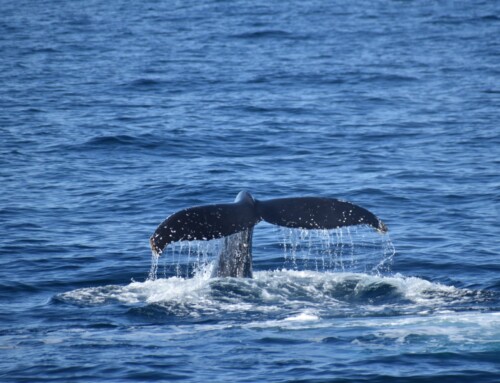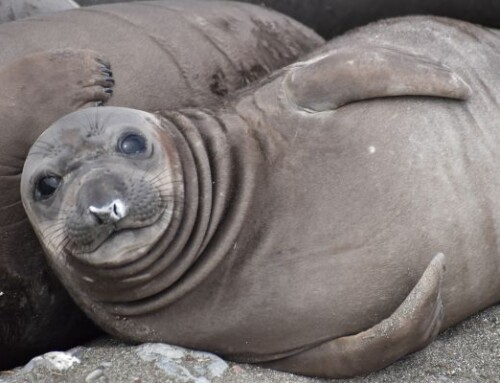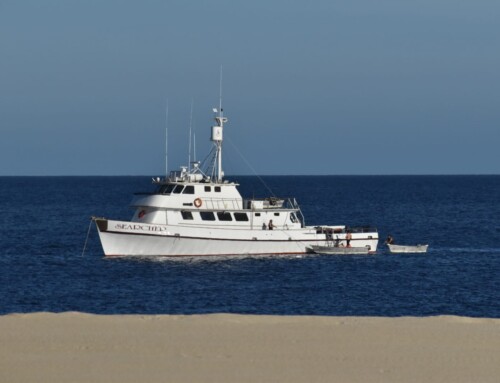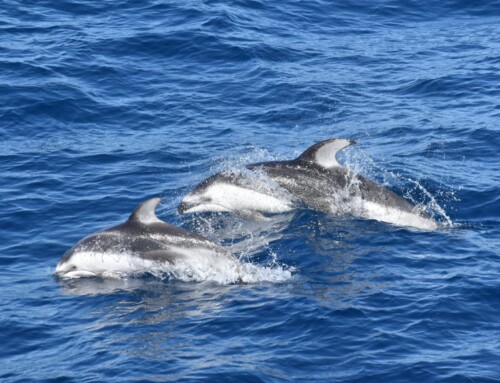DATE: April 13- 17, 2005
TRIP: Offshore Birding Trip
Daily Journal
13 April: San Diego towards Los Angeles.
We departed Fisherman’s Landing at noon on Wednesday the 13th, and headed to the bait docks so many of our out-of-state and Canadian birders could fill up on local species such as Brandt’s Cormorants, Western gulls, Heermann’s Gulls, and the ubiquitous California Sea Lions. From here we headed out of San Diego Harbor, out past Point Loma, and once we were three miles offshore, given access to the upper deck and bridge area, from where our view of our surroundings improved dramatically. The ocean temperature was near 60° F (15° C.), During the day the weather was comfortable, with slight NW winds, temperatures in the low 60’s and a 3-4’ swell out of the NW. Nothing out of the ordinary, but enough to make at least one of your leaders queasy. Once out on the ocean, we headed NNW paralleling the coast at a distance of 10-20 miles for the remainder of the day. Apart from the bird species, we also had good looks at fin whales, a species we’ve seen in this area each of the three years that we’ve now done these trips.
14 April: Santa Barbara Channel, Anacapa Island, Santa Cruz Basin, Santa Rosa Passage, Cojo Anchorage.
At 0500 we were south of Santa Barbara, but with a bit of a swell out of the W, and the weather forecast predicting increasing winds throughout the day, we decided to spend the day more comfortably and headed SE towards Anacapa Island. We reached the island a little after breakfast, and circumnavigated this smallest of the Channel Islands while keeping an eye out for Pigeon Guillemots and Pelagic Cormorants. Both species were seen to everyone’s satisfaction, while a few handfuls of popcorn seemed to attract every Western gull on the island. We passed Arch rock on the east end of the island and then headed SW towards the Santa Cruz Basin, a deepwater region that lies to the south of Santa Cruz and Santa Rosa Islands. An additional benefit of this route was that it allowed us to bird comfortably throughout the day while in the lee of the northern Channel Islands. by 2 PM we were near the Santa Rosa Passage, and the number of Pigeon Guillemots and Pacific Loons increased, a sure sign that the water was getting shallower. We finally entered the western edge of the Santa Barbara Channel, and headed NW towards Cojo Anchorage, just east of Point Conception. By now the wind had worked up a considerable swell, but it amounted to a few hours of pitching before we entered the lee of the mainland and pulled into Cojo Anchorage. Here the wind was blowing over 20 mph (35 km/h), but with land within ½ mile we rode at anchor comfortably. As a bonus we picked up three Gray Whales, a Turkey Vulture, several Black Brant, and a Barn Swallow. An unusual touch was seeing trains pass by along the coast and hearing their whistles as the evening closed in. After another fine supper, everyone got a good night’s sleep, at least until 0400.
15 April Cojo Anchorage, Patton Escarpment, San Juan Seamount
Kevin Ward pulled the anchor at 0400, and headed as close to the wind as he dared once we left the lee of the mainland. We were trying for a SW course, but the swells were a bit too large, so we settled for a heading of 190°, which would take us towards San Juan Seamount by the afternoon. At first light we were NW of San Miguel Island, the water temperature was close to 50° F (10° C), and the wind was gusting above 30 mph, or near-gale conditions. Luckily, we had the swells on our stern quarter, and the “Searcher” rode them well. Large numbers of birds were present, including dozens of Bonaparte’s Gulls, several Common Murres, and small flocks of Cassin’s Auklets. Most passengers were still in their bunks at 0630 when the first Murphy’s Petrel crossed in front of the bridge at about 30’. Todd McGrath immediately got on the intercom, called out the sighting, but to no avail; the bird was long gone, and the intercom was out of commission due to a loose wire. The wire was tightened, the bird re-announced, and wonder of wonders, suddenly 20 people were out on deck waiting for the next sighting. It came rather quickly, once again passing in front of the boat, but at 0745 a third Murphy’s Petrel came up the wake and hung above the stern for close to a minute before veering off. It was called out by one of the leaders, seen well by everyone, and then strung into a Northern Fulmar by the leader who didn’t see sufficient white wing flash to feel comfortable with the identification. Never mind the smaller size, pale chin, dark bill, jerky flight style, bent wings and leaner jizz. Upon due reflection everyone agreed that the leader had suffered an acute attack of single field-characteristicitis, and the Murphy’s Petrel was added to everyone’s life list. By now the water temperature had risen to 56° F (13° C). We continued on this same heading for much of the day, seeing a nice variety of species, including Laysan and Black-footed Albatross, Leach’s Storm-petrel, and good numbers of Pomarine Jaegers that dove for popcorn in the wake. While the weather was impressive, with swells approaching 14’ in height, sailing downwind made for one of those memorable days at sea when one could enjoy the immensity and power of the ocean without suffering the usual side effects. As the day progressed and we got farther south the wind began to lessen, the swells decrease, and after passing over the San Juan Seamount, we headed Southeast over deeper water and reaching the Patton Escarpment by evening.
16 April: Patton Escarpment, Butterfly Bank, 60 Mile Bank
During the night we motored slowly SSE along the Patton Escarpment, and at 0500 were approximately 80 miles (130 km) south of San Nicolas Island. The water temperature was 60.6° F (15.9° C). At this point we turned the “Searcher” around, and began heading upwind, laying out a menhaden oil slick, and boiling cabbage on the galley stove. The idea with the cabbage was that it gives off dimethyl sulfide when heated, which is the same compound released by zooplankton when they feed on phytoplankton. Procellarids are sensitive to this smell, and will fly towards it. We moved upwind for 2 hours before retracing our steps. The slick and cabbage fumes did their magic, and we were rewarded with a Murphy’s Petrel, a Laysan Albatross, a Black-footed Albatross, and several Leach’s Storm-petrels. Not too bad a start to the bird list before 8 AM. The Murphy’s Petrel left us after a while, but the two albatrosses lingered. We began heading east, looking for warmer waters and Red-billed Tropicbirds, but there were few birds visible for much of the time, with only an occasional albatross coming up the stern to investigate us. As we traveled east the water temperature dropped by a dgree or two, and we began to see surprisingly large numbers of Red Phalaropes and Cassin’s Auklets. Leach’s Storm-petrels were also seen on a regular basis, but we were still looking for tropicbirds. Finally by mid –afternoon we spotted first one and then a second Red-billed Tropicbird, both were first spotted on the water, and then flew off as we approached them. Sighting a group of three sperm whales was also a treat. As the afternoon wore on we stopped at Sixtymile Bank, let out a large slick, and had a good gathering of Black Storm-petrels, a few fulmars, and a Black-footed Albatross that gave wonderful views as it devoured some chum near the “Searcher”. Once everyone had seen their fill of these birds, we decided to leave the USA, crossed into Mexican waters, and quickly tallied eight species, including excellent looks at several pairs of Xantus’ Murrelets. We continued to bird until dark, but finally had to give up as it became too dark to identify the birds we saw. We decided to call is a trip. Dinner beckoned, and after one last wrap-up, we all got a good night’s sleep before docking at the berth in San Diego at 7 Am the following morning.
Picture Gallery
| Species | 4/13 | 4/14 | 4/15 | 4/16 | Totals |
| Pacific Loon | 4 | 40 | 44 | ||
| Red-throated Loon | 1 | 1 | |||
| Common Loon | 1 | 1 | 2 | ||
| Eared Grebe | 2 | 1 | 3 | ||
| Laysan Albatross | 3 | 3 | 6 | ||
| Black-footed albatross | 3 | 3 | 6 | ||
| Northern Fulmar | 1 | 3 | 6 | 10 | |
| Murphy’s Petrel | 9 | 1 | 10 | ||
| Sooty Shearwater | 25 | 375 | 95 | 1 | 496 |
| Pink-footed Shearwater | 20 | 40 | 30 | 90 | |
| Flesh-footed Shearwater | 1 | 1 | |||
| Black-vented Shearwater | 15 | 50 | 65 | ||
| Leach’s Storm-petrel | 15 | 75 | 90 | ||
| Black Storm-petrel | 2 | 24 | 26 | ||
| Red-billed Tropicbird | 2 | 2 | |||
| Brown Pelican | 37 | 100s | 37 | ||
| Double-crested Cormorant | 21 | 15 | 36 | ||
| Brandt’s Cormorant | 150 | 1,000 | 1,150 | ||
| Pelagic Cormorant | 50 | 50 | |||
| Black Brant | 25 | 25 | |||
| Surf Scoter | 4 | 30 | 34 | ||
| Black Oystercatcher | 2 | 2 | 4 | ||
| Turkey Vulture | 1 | 1 | |||
| Red Phalarope | 2 | 15 | 200 | 180 | 397 |
| Red-necked Phalarope | 55 | 75 | 300 | 430 | |
| Pomarine Jaeger | 2 | 7 | 20 | 1 | 30 |
| Parasitic Jaeger | 2 | 2 | |||
| Heermann’s Gull | 11 | 3 | 14 | ||
| Bonaparte’s Gull | 31 | 200 | 65 | 296 | |
| California Gull | 23 | 50 | 73 | ||
| Western Gull | 155 | 1,000 | 51 | 11 | 1,217 |
| Glaucous-winged Gull | 1 | 1 | |||
| Herring Gull | 2 | 2 | |||
| Sabine’s Gull | 50 | 7 | 57 | ||
| Elegant Tern | 31 | 4 | 35 | ||
| Royal Tern | 2 | 2 | 4 | ||
| Forster’s Tern | 1 | 8 | 9 | ||
| Pigeon Guillemot | 60 | 60 | |||
| Cassin’s Auklet | 4 | 20 | 100 | 90 | 214 |
| Common Murre | 5 | 5 | |||
| Xantus’s Murrelet | 2 | 2 | 2 | 3 | 9 |
| Rhinoceros Auklet | 2 | 35 | 20 | 1 | 58 |
| Rufous Hummingbird | 1 | 1 | |||
| Barn Swallow | 1 | 1 | |||
| Whale sp. | 1 | 1 | |||
| Gray Whale | 3 | 3 | |||
| Humpbacked Whale | 4 | 4 | |||
| Fin whale | 3 | 1 | 4 | ||
| Sperm Whale | 3 | 3 | |||
| Dall’s Porpoise | 2 | 2 | |||
| Risso’s Dolphin | 8 | 8 | |||
| Long-beaked Common dolphin | 55 | 55 | |||
| Short-beakd Common Dolphin | 25 | 25 | |||
| Pacific White-sided Dolphin | 15 | 8 | 23 | ||
| Northern Right-whale Dolphin | 10 | 10 | |||
| California Sea Lion | 100 | 15 | 3 | 118 | |
| Guadalupe Fur Seal | 2 | 2 |






